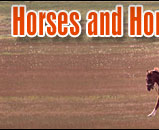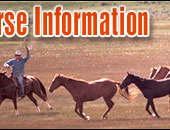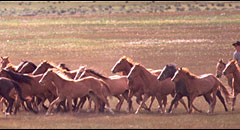 |
   |
|
|
|
You are here: Horses > Horse health > Equine Ringworm & Rain rot |
Controlling Horse Ringworm and Rain Rot Skin Diseases
One good indicator of a horse’s general physical condition
is the state of its coat. A horse with a smooth, shiny coat
is usually in good health, while a rough, dull, or patchy
coat is a sign of underlying health problems. |
|
|
A horse’s skin is constantly under attack by a wide variety
of viruses, bacteria, and biting insects. Symptoms of skin
diseases can range from a simple, isolated skin lesion to
generalized itching and hair loss over the entire body. Two
of the most common varieties of skin diseases are ringworm,
also called dermatophytosis, and rain rot, which
is also known as dermatophilosis. Ringworm is a skin
infection caused by a fungus, not a worm. It spreads between
horses thorough the use of common grooming tools, saddle
pads, or |
harnesses. Also, damp, dark,
and crowded conditions (such as horses confined to their
stable during the winter and fall) can predispose horses to
contracting ringworm.
 Ringworm is most common in horses under three years of age,
and older or debilitated animals. It initially presents as
small, circular patches of hair loss with scabbed or flaky
skin beneath. If left untreated, these circular lesions will
grow into large, irregular areas of broken hairs and
blisters with scabs. These areas are susceptible to
secondary skin infections. Ringworm is most common in horses under three years of age,
and older or debilitated animals. It initially presents as
small, circular patches of hair loss with scabbed or flaky
skin beneath. If left untreated, these circular lesions will
grow into large, irregular areas of broken hairs and
blisters with scabs. These areas are susceptible to
secondary skin infections.
The lesions are most typically seen around the girth and
saddle areas, on the face and around the eyes, and on the
legs. Sometimes the lesions are extremely itchy. It is also
very contagious, spreading between horses and even from
horses to humans.
If ringworm is suspected, treatment should start right away.
The infected horse should be isolated from others, and all
tack and grooming equipment should be disinfected. This can
be done with a solution of one part bleach to ten parts
water. Also, a shampoo medicated with miconazole should be
used daily on the horse for five days, and then weekly until
all the lesions are fully healed.
Another irritating skin condition is rain rot. Also known as
rain scald, or dew poisoning if seen on the lower limbs, it
is caused by a bacterium with fungal characteristics.
The bacteria live in the soil and generally cause infections
during periods of prolonged wet weather, hence the name. It
is contagious and can be spread to other horses by infected
animals. Other contributing factors are poor stable hygiene
and skin irritation caused by insect bites.
Horses with rain rot generally present with a series of
small bumps down their backs. The lesions progress to form
circular scabs and matted tufts of hair. Removal of these
mats is painful and can cause raw, bleeding, irritated
areas. Veterinarians sometimes call these circular tufts
“paintbrush lesions.” These are generally seen on the back,
rump, neck and legs.
Animals that have rain rot should be kept dry and protected
from biting insects. The horse should be bathed daily in
iodine shampoo, chlorohexidine shampoo, or benxoyl peroxide,
and the scabs should be removed during shampooing daily for
a week. Severe infections may require antibiotic treatment
as well. The best treatment for rain rot is sunshine and
warm, dry weather.
Skin conditions should be treated early, before the
resulting itching, hair loss, and inflammation result in
oozing, crusting, and scaling of the skin. The proper
diagnosis of skin diseases may require additional
investigation and cannot be reliably pinpointed simply by
looking.

|
Read the next horse health tips article on Stifle Problems. |
|
|
|
|
 |
|
|
|
|
|
Horse Education
|
|
|
|
|
Horse Information Topics
|
|
|
|
|
|
|
|
Horse Business Owners
|
| |
Advertise with Us
Have your horse products or services exposed to over 27,000 of our monthly visitors.
|
|
|
|
|
|